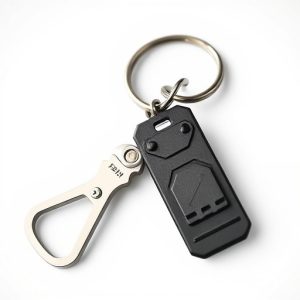Keychain Pressure Point Defense: Legal Requirements & Safety Check
Keychain pressure point defense moves are popular for personal safety but their legality varies glob…….
Keychain pressure point defense moves are popular for personal safety but their legality varies globally. Users must understand age restrictions, permit requirements, and rules against aggressive use, as these devices are categorized based on force output. Staying informed about local laws ensures responsible usage, especially employing them as a last resort against imminent threats, to avoid legal repercussions. Safety standards, including clear instructions for deployment and de-activation, prevent unintended harm or misuse, enhancing legal defensibility. Regional variations in regulations highlight the diverse legal landscape, underscoring the importance of understanding state-by-state guidelines before acquiring these devices. Choosing products designed with user well-being in mind and rigorously tested to meet industry standards ensures reliability and performance over time. Regular practice sessions and staying updated on legal provisions are crucial for effective and legally sound deployment.
In today’s world, personal safety is paramount. Keychain pressure point defense moves have emerged as a convenient self-defense option, but legal requirements and user responsibilities are crucial considerations. This article delves into the key legal aspects surrounding keychain self-defense devices, exploring regional variations in regulations and safety features that ensure legitimacy. We also examine training protocols and user duties for effective deployment, providing a comprehensive guide to navigating the legal landscape of keychain pressure point defense moves.
- Understanding Keychain Pressure Point Defense Moves: A Legal Perspective
- Key Legal Considerations for Deploying Keychain Self-Defense Devices
- Regional Variations in Regulations: Exploring State-by-State Guidelines
- Safety Features and Testing Protocols for Legitimate Self-Defense Equipment
- User Responsibilities and Training Requirements for Effective Deployment
Understanding Keychain Pressure Point Defense Moves: A Legal Perspective
Keychain Pressure Point Defense Moves are a popular self-defense tool, but it’s crucial to understand their legal implications. While many countries allow citizens to carry self-defense devices for personal safety, there are strict regulations regarding what constitutes an acceptable weapon and the circumstances under which they can be used. In terms of keychain pressure point defense moves, this translates to considering factors like age restrictions, permit requirements, and prohibitions against aggressive or unnecessary use.
From a legal perspective, these keychains are often categorized based on their design and force output. Devices that deliver a powerful strike or have a significant risk of causing harm may face stricter regulations. It’s essential for users to be aware of local laws and only employ such devices as a last resort when facing an imminent threat. Staying informed about legal boundaries ensures responsible use and avoids potential legal repercussions.
Key Legal Considerations for Deploying Keychain Self-Defense Devices
When considering the deployment of keychain pressure point defense moves as a self-defense device, there are several key legal considerations to bear in mind. The first is understanding the legal definitions and regulations surrounding self-defense devices in your jurisdiction. Some regions have strict guidelines on what constitutes a legal self-defense tool, including restrictions on force levels and specific design requirements. For instance, certain states may permit only non-lethal keychain defense devices, while others might allow more robust options under specific circumstances.
Additionally, manufacturers and users must adhere to safety standards to ensure the responsible use of these devices. This includes clear instructions for proper deployment and de-activation, as well as safeguards to prevent unintended harm or misuse. Compliance with relevant laws not only ensures legal defensibility but also promotes the safe integration of keychain pressure point defense moves into personal safety strategies.
Regional Variations in Regulations: Exploring State-by-State Guidelines
Regional Variations in Regulations highlight the diverse landscape of legal requirements across different states, especially concerning keychain pressure point defense moves. While some regions have stringent regulations on self-defense devices, others maintain more lenient standards. This variability underscores the need for individuals to be vigilant and informed about their local laws before acquiring any keychain safety device.
For instance, certain states may permit the use of keychains with built-in pressure points for personal protection, subject to specific conditions such as age restrictions or requirements for proper training. Conversely, some states might prohibit or heavily regulate such devices due to concerns related to public safety and potential misuse. Understanding these state-by-state guidelines is crucial for ensuring compliance and peace of mind when carrying a keychain pressure point defense move.
Safety Features and Testing Protocols for Legitimate Self-Defense Equipment
When evaluating a keychain pressure point defense move as a legitimate self-defense equipment, it’s crucial to consider its safety features and testing protocols. These devices should be designed with user safety at the forefront, ensuring minimal risk of injury during use. Look for products that undergo rigorous testing to validate their effectiveness and safety, adhering to industry standards and regulations.
The testing protocols should encompass a wide range of scenarios, including simulated stress tests, durability assessments, and controlled impact evaluations. These tests ensure the keychain pressure point device can withstand everyday wear and tear while maintaining its structural integrity and performance. Additionally, independent third-party certification can provide assurance that the product meets specific safety requirements, giving users confidence in its reliability for personal defense.
User Responsibilities and Training Requirements for Effective Deployment
When deploying a keychain pressure point defense move, users must first understand their responsibilities in ensuring its effectiveness and legality. It’s crucial for individuals to familiarize themselves with local laws regarding self-defense tools, including keychains designed for pressure points. User training is essential; it should cover proper handling, safe storage, and awareness of potential risks and limitations. This includes recognizing when and how to apply pressure points for maximum impact while minimizing the chance of injury to oneself or others.
Regular practice sessions are a key component of responsible usage. Training should include scenarios that mimic real-life situations, enabling users to react instinctively in stressful environments. It’s also important to stay updated on any changes in legal provisions related to self-defense devices, as these can vary significantly by jurisdiction. Users should consult local law enforcement or legal experts to ensure they remain compliant with current regulations, thereby enhancing the legal validity of their defense moves if needed.
When considering the legal implications of keychain pressure point defense moves and self-defense devices, it’s clear that navigating regional regulations is a multifaceted challenge. Understanding key legal considerations, safety features, and user responsibilities is essential for ensuring these tools remain effective and legitimate means of personal protection. As the use of such devices continues to evolve, staying informed about state-by-state guidelines and industry standards will be crucial for both users and manufacturers alike.


